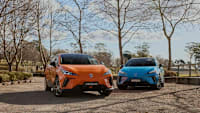Should you turn on your headlights when it's raining?
The answer is: Yes. It’s all about common sense* and visibility.
Turning on your headlights makes your vehicle more easily seen by other drivers and for you, the driver, it makes the task of being able to see the road or track more clearly ahead of you in those same conditions easier.
*Obviously, when driving in rain or low-light conditions, you should also slow down, keep a greater distance between you and the vehicle you’re following and generally drive to suit the demands of those conditions, but for the purpose of this article, we’re focusing on lighting.
Which lights to use in rain? Use whatever’s available to you. Many vehicles have daytime running lights (DRLs) and headlights that activate in low-light conditions.
But other vehicles require the driver to switch the headlights on. If your vehicle has DRLs and the headlights haven’t yet switched on automatically in a low-light situation, turn them on yourself.
What purpose do headlights serve? Well, again, that requires a simple response.
Car manufacturers put headlights on their cars so their vehicles look cool. Only joking. The function of headlights is to illuminate the road ahead – the act of which is called the headlights’ throw – as well as some of the areas to the sides of the road – the act of which is called the headlights’ spread.
_0.jpg)
Fog lights and aftermarket lights offer more flexibility in terms of how far ahead and to the side they illuminate, but for the purpose of this yarn we’re referring to the standard headlights that are on a new vehicle at time of purchase.
How do headlights improve road safety? Again, headlights make your vehicle more visible – giving other drivers the time and space to drive to recognise where you are on the road and drive accordingly.
And the headlights on your vehicle make your job – keeping you, your family and other road users safe on the road – easier because you’re able to maximise your view of the road ahead, thus improving your ability to recognise risks and – best-case scenario – anticipate them or – not-so-best-case scenario – at least effectively react to them.
When are they most commonly used? Headlights are most commonly used during the night or early morning, but they should also be used in any low-light conditions (e.g. rain, fog, pre-dawn, dawn, pre-dusk, dusk, etc).
If it's getting dark, or it starts raining, which lights should you use? DRLs are great for general use, but they’re not headlights, so switch on your headlights.
.jpg)
Should you turn on your headlights when it's raining? Why? Yes, you should. For those exact same reasons already mentioned.
Turning on your headlights makes your vehicle more visible and it makes the task of driving your vehicle safer because switching on headlights will help you see the road or loose surface track.
Does it differ depending on the severity of weather? Yes, but it’s a good rule to turn on your headlights as soon as visibility becomes less than ideal.
That is, any conditions in which light is less than ideal. Put your fog lights on in fog, put your headlights on in any other conditions.
When should you switch your headlights on? When you’re driving between sunset and sunrise and in any other low-visibility or otherwise hazardous conditions.
.jpg)
Are there any circumstances where you should not turn on your headlights when it's raining? No, but if you believe there are, feel free to let us know in the Comments section.
When should you dip your headlights? If you have your headlights on high beam, dip them back to low beam or 'normal' before travelling within 200m of a vehicle travelling in the same direction, or before driving to within 200m of an oncoming vehicle.
Don’t use your headlights on high beam “if travelling less than 200m behind a vehicle travelling in the same direction, or when less than 200m from an oncoming vehicle”, according to the NSW government.
That distance may vary from state to state, and I’d opt for a greater distance, say 400m, just out of old school courtesy, but the 200m guideline is a good rule of thumb.
How do the rules differ from state to state in Australia? This is a road rule that all states and territories tend to agree on.
.jpg)
Headlights must be on when driving between sunset and sunrise. In fact, Transport NSW states headlights should also be switched on “At any other time when there is not enough daylight to be able to see a person wearing dark clothing at a distance of 100 metres”.
What other kinds of weather warrant turning on headlights? Better to be safe than sorry and switch on your headlights in any low-light conditions and, as well as those scenarios already mentioned, those sorts of conditions may also include any hazardous weather conditions, such as hail, snow, storms, dust, even high winds etc.
VicRoads states that your vehicle’s headlights must be on “in hazardous conditions where there is reduced visibility”. If you have to switch on your windscreen wipers, then you should turn on your headlights. That’s if they’re not already switched on.
Are there penalties if you do not turn on your headlights when it's raining? Well, as with many road rules, laws applying to the use of headlights may be interpreted and applied at the officer’s discretion and that may differ from state to state and territory.
For instance, in NSW, if you “Drive during period of darkness without prescribed lights” you are liable for a $116 fine and one demerit point.
.jpg)
In Queensland, if you don’t have your vehicle’s headlights on between sunset and sunrise or in hazardous conditions the driver is liable for a $154 fine and one demerit point. So these depend on the officer’s interpretation of what constitutes a “period of darkness” and “hazardous conditions”.
It’s best to put your headlights on as soon as there is not enough daylight to be able to see a person wearing dark clothing at a distance of 100 metres. In fact – and feel free to call me a cautious old codger – I put my headlights on even earlier than that.








.jpg)

.jpg)

.jpg)

.jpg)


.jpg)
.jpg)




.jpg)
.jpg)
.jpg)


.jpg)